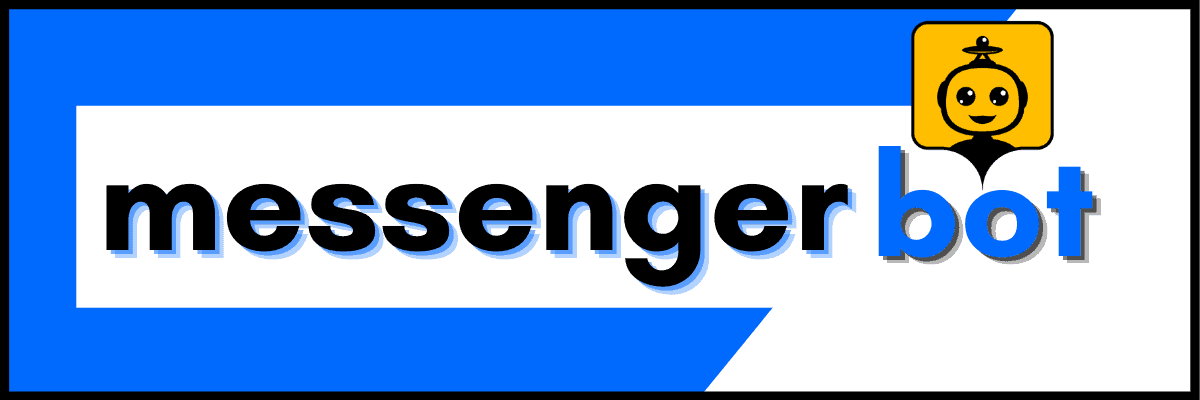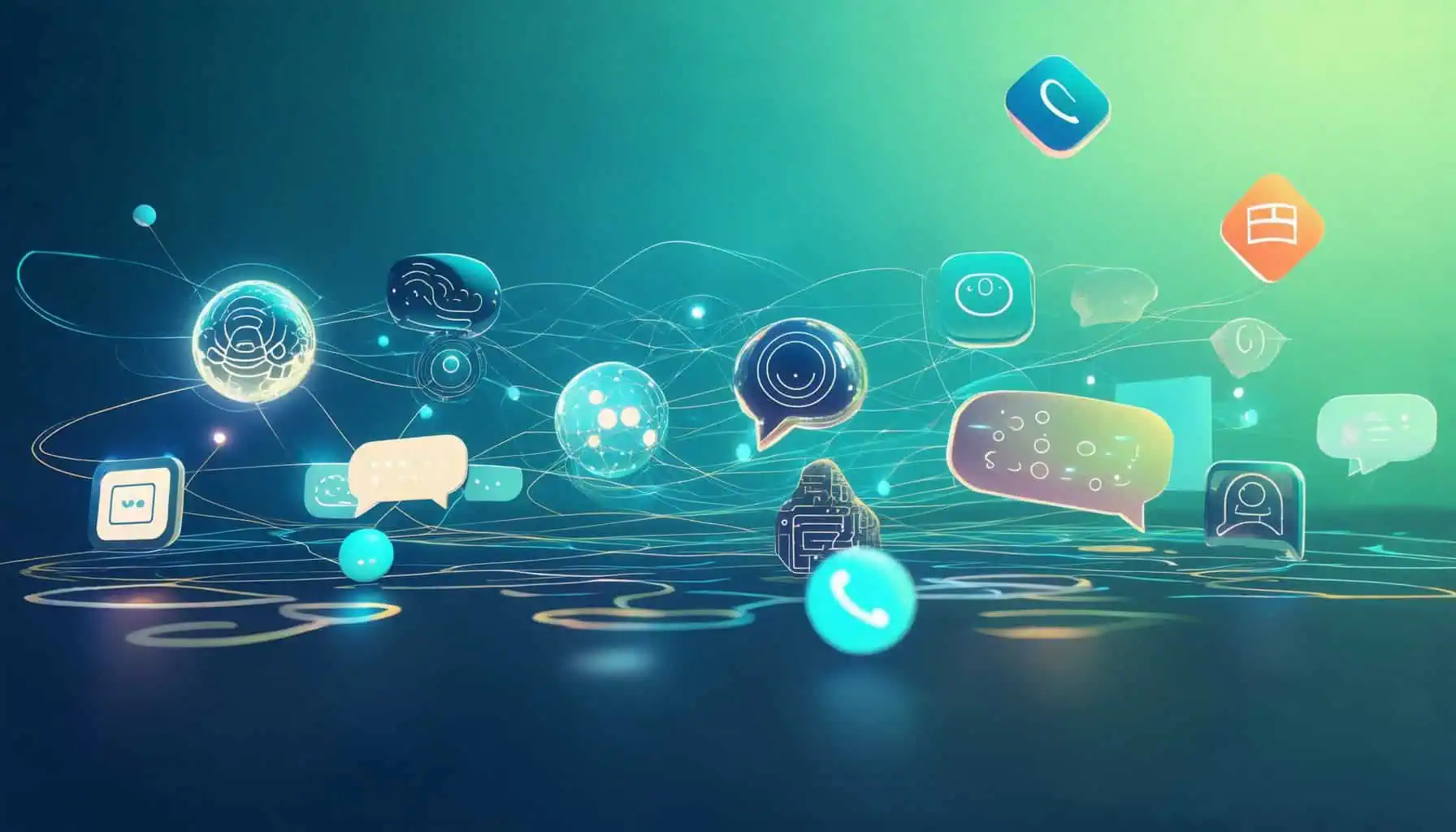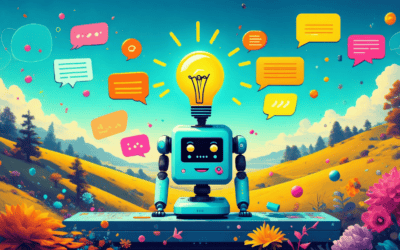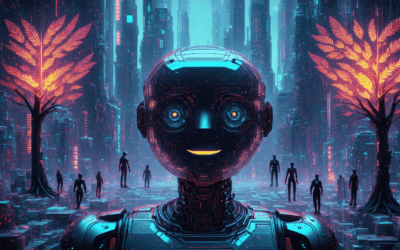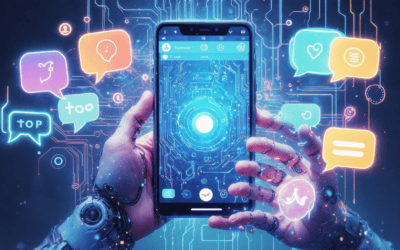Puntos Clave
- Essential Role of Basic Chatbots: Basic chatbots enhance customer engagement and streamline communication by providing instant responses and task automation.
- Types de chatbots : Understand the four main types—Menu-Based, Rule-Based, AI-Powered, and Voice Chatbots—to choose the right fit for your business needs.
- Solutions rentables : Simple chatbots can be developed for as low as $50/month, with free options available for basic functionalities, making them accessible for all businesses.
- Easy Creation Techniques: Platforms like Dialogflow and Chatfuel allow you to create chatbots without coding, making it easy for beginners to enhance digital interactions.
- Informations basées sur les données : Chatbots collect valuable user data that can refine marketing strategies and improve customer service, driving better business decisions.
Dans le paysage numérique d’aujourd’hui, basic chatbots have emerged as essential tools for enhancing communication and customer engagement. This article delves into the world of basic chatbots, providing a comprehensive understanding of their definition, significance, and the various types available. We will explore the four main types of chatbots, their unique use cases, and guide you through the process of creating a simple chatbot, including a beginner-friendly approach using Python. Additionally, we will break down the costs associated with developing a simple chatbot and discuss whether popular voice assistants like Alexa can be classified as chatbots. For those interested in creating their own chatbot for free, we will highlight platforms and resources that can help you get started. Join us as we uncover the valuable insights and practical techniques that will empower you to navigate the exciting realm of basic chatbots.
What is a basic chatbot?
A basic chatbot is an artificial intelligence (AI) application designed to simulate human conversation through text or voice interactions. These chatbots utilize natural language processing (NLP) and machine learning algorithms to understand user queries and provide relevant responses.
Definition and Overview of Basic Chatbots
Key features of basic chatbots include:
- Disponibilité 24h/24 et 7j/7: Chatbots can operate around the clock, offering immediate assistance to users without the need for human intervention. This ensures that customer inquiries are addressed promptly, enhancing user satisfaction.
- Automatisation des tâches: By handling repetitive tasks such as answering frequently asked questions or processing simple transactions, chatbots free up human agents to focus on more complex issues, thereby increasing overall efficiency in customer service.
- Engagement des utilisateurs: Basic chatbots can engage users through personalized interactions, guiding them through processes such as product selection or troubleshooting, which can improve the overall customer experience.
- Intégration avec les plateformes de messagerie: Many basic chatbots can be integrated into popular messaging platforms, such as Facebook Messenger, allowing businesses to reach customers where they already communicate. This integration enhances accessibility and user convenience.
- Collecte et analyse de données: Chatbots can gather valuable data from user interactions, providing insights into customer preferences and behaviors. This information can be used to refine marketing strategies and improve service offerings.
According to a report by Gartner, by 2025, 75% of customer service interactions will be powered by AI, including chatbots, highlighting their growing importance in the digital landscape. In summary, basic chatbots serve as essential tools for businesses looking to enhance customer service efficiency, improve user engagement, and leverage data for better decision-making.
Importance of Basic Chatbots in Modern Communication
In today’s fast-paced digital environment, the importance of basic chatbots cannot be overstated. They play a crucial role in streamlining communication between businesses and customers. By providing instant responses and automating routine inquiries, chatbots significantly enhance user experience and satisfaction.
Moreover, the integration of chatbots into various messaging platforms allows businesses to maintain a constant presence in the digital space. This accessibility not only improves customer engagement but also fosters loyalty, as users appreciate the convenience of immediate assistance.
As companies increasingly adopt AI technologies, the reliance on basic chatbots is expected to grow. Their ability to analyze user data and adapt interactions accordingly makes them invaluable for tailoring marketing strategies and improving service delivery. For businesses looking to stay competitive, leveraging basic chatbots is essential.
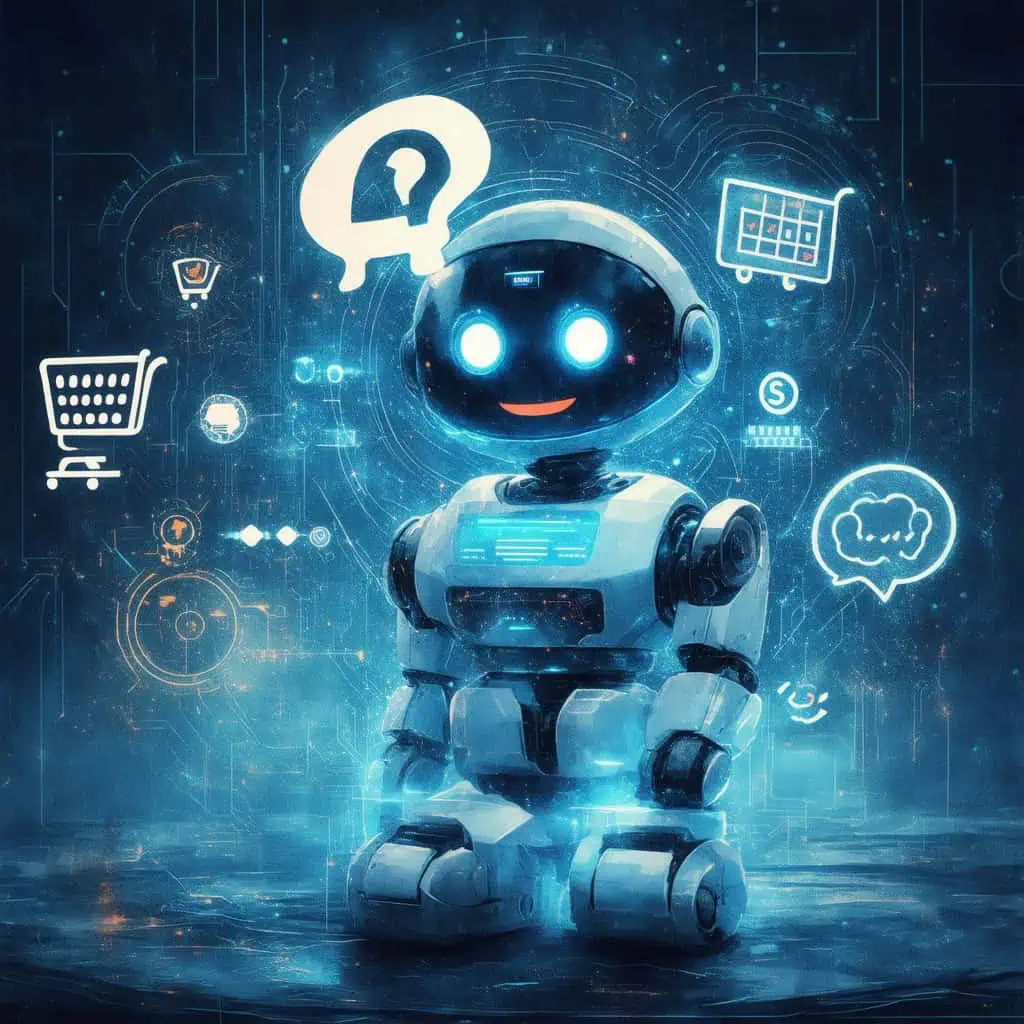
Quels sont les 4 types de chatbots ?
Understanding the different types of chatbots is essential for businesses looking to enhance their customer interactions. Here are the four main types of chatbots:
Exploring the Four Main Types of Chatbots
- Chatbots basés sur des menus ou des boutons: These are the simplest form of chatbots that guide users through a predefined set of options. Users interact by selecting buttons or menu items, making it easy for businesses to streamline customer inquiries and provide quick responses.
- Chatbots basés sur des règles: These chatbots operate on a set of predefined rules and scripts. They can handle specific queries by following a decision tree, but their capabilities are limited to the scenarios they are programmed for. This type is effective for straightforward tasks but lacks the flexibility of more advanced chatbots.
- Chatbots alimentés par IA: Utilizing natural language processing (NLP) and machine learning, AI-powered chatbots can understand and respond to user queries in a more conversational manner. They learn from interactions, improving their responses over time. These chatbots are increasingly popular for customer service and engagement due to their ability to handle complex inquiries.
- Chatbots vocaux: These chatbots use voice recognition technology to interact with users through spoken language. They are commonly found in virtual assistants like Amazon’s Alexa or Google Assistant, allowing users to perform tasks hands-free. Voice chatbots are gaining traction as voice search becomes more prevalent.
Use Cases for Each Type of Chatbot
Each type of chatbot serves distinct purposes and can be utilized in various scenarios:
- Chatbots basés sur des menus ou des boutons: Ideal for FAQs and basic customer support, these chatbots can efficiently guide users to the information they need without complex interactions.
- Chatbots basés sur des règles: Best suited for industries with repetitive queries, such as banking or retail, where specific information is required consistently.
- Chatbots alimentés par IA: Perfect for customer service applications, these chatbots can handle nuanced conversations, making them valuable for businesses that prioritize customer engagement.
- Chatbots vocaux: Increasingly used in smart home devices and mobile applications, voice chatbots enhance user experience by allowing hands-free operation and accessibility.
For more insights on chatbot functionalities and their applications, check out Diverse chatbot use cases.
How to Make a Simple Chatbot?
Creating a simple chatbot can significantly enhance user interaction and streamline communication for businesses. By following a structured approach, you can develop a chatbot that meets your specific needs and engages users effectively. Here’s a step-by-step guide on how to make a simple chatbot:
- Choisissez une plateforme: Select a chatbot development platform that suits your needs, such as Dialogflow, Chatfuel, or ManyChat. These platforms offer user-friendly interfaces and various features.
- Définir l'objectif: Clearly outline what you want your chatbot to achieve. This could include answering FAQs, providing customer support, or guiding users through a process.
- Concevoir le flux de conversation: Map out the conversation paths your chatbot will take. Use flowcharts to visualize interactions and ensure a seamless user experience.
- Create the Bot:
- Configurez Votre Chatbot: Use your website URL to integrate the chatbot into your site.
- Entraînez votre chatbot: Input common questions and responses to help the bot understand user queries.
- Ajustez votre chatbot: Adjust the bot’s responses based on user interactions to improve accuracy.
- Testing Tool: Utilize built-in testing tools provided by your chosen platform to simulate conversations and identify areas for improvement.
- Créez et configurez votre widget de chat: Customize the appearance of your chat widget to match your website’s branding. This includes colors, fonts, and placement on the page.
- Configurez les salutations: Program personalized greetings to engage users when they first interact with the chatbot.
- Preview the Chat Widget: Before going live, preview the chat widget to ensure it functions correctly and provides a positive user experience.
- Lancez et surveillez: Once satisfied with the setup, launch your chatbot. Continuously monitor its performance and gather user feedback to make necessary adjustments.
For further insights, consider exploring resources from reputable sources such as the IBM AI Chatbot and industry blogs that provide valuable information on chatbot design and user engagement strategies.
How to Make a Chatbot in Python: A Beginner’s Approach
If you’re interested in programming your own chatbot, Python is an excellent language to start with due to its simplicity and powerful libraries. Here’s a beginner-friendly approach to creating a chatbot in Python:
- Configura tu entorno: Install Python and set up a development environment. You can use IDEs like PyCharm or Jupyter Notebook for ease of use.
- Install Required Libraries: Utilisez des bibliothèques telles que NLTK pour le traitement du langage naturel et ChatterBot for building conversational bots.
- Définissez l'objectif de votre bot: Similar to other platforms, define what your bot will do. Will it answer questions, provide recommendations, or assist with tasks?
- Build the Bot Logic: Write the code to handle user inputs and generate responses. Use conditional statements to create conversation flows.
- Train Your Bot: Input sample conversations to help your bot learn how to respond appropriately to user queries.
- Tester votre bot: Run tests to ensure your bot responds correctly and refine its logic based on feedback.
- Déployez votre bot: Once satisfied, deploy your chatbot on a platform like Flask or Django to make it accessible online.
For more detailed tutorials on chatbot development, check out the Tutoriels Messenger Bot for comprehensive guides and resources.
¿Cuánto cuesta un chatbot simple?
The cost of a simple chatbot can vary significantly based on several factors, including the complexity of the bot, the platform used, and the features required. Understanding these costs is crucial for businesses looking to enhance their digital communication through automation.
Breakdown of Costs Associated with Simple Chatbots
Here’s a breakdown of typical pricing structures for simple chatbots:
- Chatbots de base : You can start with a basic chatbot for as low as $50 to $60 per month. This pricing typically covers a single bot with limited functionalities.
- Multiple Bots: If you need to deploy multiple chatbots across different domains or platforms, costs can exceed $100 per month. This is especially true for businesses looking to enhance customer engagement across various channels.
- Fonctionnalités Avancées : For chatbots that require advanced features such as natural language processing (NLP), machine learning capabilities, or integration with customer relationship management (CRM) systems, prices can rise significantly. Enterprise plans often start at several hundred dollars per month, offering customization, enhanced security, and dedicated support.
- Free Options: Some platforms offer free versions with basic functionalities, which can be a good starting point for small businesses or individuals testing the waters.
- Bots Messenger : If you are considering integrating a Messenger Bot, many platforms provide specific pricing models for bots designed for social media interactions. These can range from free to premium plans depending on the features and user engagement levels.
Factors Influencing the Cost of Chatbot Development
Several factors can influence the overall cost of developing a simple chatbot:
- Complexity: The more complex the chatbot’s functionalities, the higher the cost. Basic bots with simple scripts are cheaper than those requiring advanced AI capabilities.
- Platform: Different platforms have varying pricing structures. For instance, integrating a Messenger Bot may have different costs compared to a web-based chatbot.
- Personnalisation : Custom-built chatbots tailored to specific business needs can significantly increase costs compared to off-the-shelf solutions.
- Maintenance et Support : Ongoing maintenance and customer support can add to the total cost, especially for businesses that require continuous updates and improvements.
For a comprehensive understanding of chatbot pricing, it’s essential to evaluate your specific needs and the potential return on investment. Always consider the scalability and adaptability of the chatbot solution you choose to ensure it meets future demands. For more insights on creating your own chatbot, check out ce guide.

Alexa est-elle un chatbot ?
Alexa is a voice-activated chatbot that utilizes advanced artificial intelligence (AI) and natural language processing (NLP) to interact with users. This innovative technology allows Alexa to engage in conversations, answer questions, and execute tasks based on voice commands, providing a more natural interaction compared to traditional chatbots.
Understanding the Functionality of Alexa as a Chatbot
Alexa’s capabilities extend beyond simple voice recognition. It employs sophisticated NLP algorithms to comprehend and interpret voice commands, enabling it to understand context, nuances, and user intent. This results in more accurate responses, making Alexa a practical assistant for various tasks, including controlling smart home devices, playing music, and setting alarms.
Moreover, Alexa has evolved to incorporate text-based interactions, allowing users to type their queries. This versatility enhances its functionality as a chatbot, bridging the gap between voice and text communication. As of December 2020, Alexa officially began to function as a chatbot with the introduction of typing features on iOS devices, reflecting the growing trend of integrating voice and text-based AI interactions.
Comparison of Alexa with Other Basic Chatbots
When comparing Alexa to other basic chatbots, its voice-activated nature sets it apart. Unlike traditional chatbots that rely solely on text input, Alexa combines the efficiency of voice recognition with the convenience of text. This unique positioning allows it to offer a richer user experience, similar to platforms like Messenger Bot, which also facilitates conversational interactions.
For further insights into the advancements in conversational AI and the functionalities of voice assistants, authoritative sources such as Voicebot.ai et AWS provide valuable information.
Is Chatbot Free?
Exploring Free Options for Basic Chatbots
Free chatbots are widely available across various platforms, providing users with basic functionalities at no cost. However, these free options often come with limitations in features and capabilities compared to their paid counterparts. For instance, many free chatbots, such as those offered by Tidio et WotNot, allow businesses to implement simple customer support solutions without any financial investment.
While free chatbots can effectively handle straightforward tasks like answering FAQs or basic lead qualification, they typically lack advanced AI capabilities. This limitation can hinder their effectiveness for businesses with more complex needs, as noted by sources like Denser.ai. For businesses looking to scale their operations, investing in a paid chatbot solution may be necessary to access advanced features and integrations.
Basic Chatbot Free Resources and Tools Available
There are several resources and tools available for creating free chatbots. Platforms like HubSpot offer free chatbot builders that allow users to create bots without any coding knowledge. These tools often provide a user-friendly interface, making it easy for businesses to set up their chatbots quickly.
For those interested in more comprehensive solutions, exploring platforms like Messenger Bot can be beneficial. This platform offers a range of features that can enhance digital communication, including automated responses and workflow automation, even in its free offerings. However, businesses should assess their specific needs and consider whether a free chatbot will suffice or if a paid option would better serve their operational goals.
Create your own chatbot free
Creating your own chatbot for free is an exciting opportunity to enhance user engagement and streamline communication. With various platforms available, you can easily design a basic chatbot tailored to your needs without incurring costs. Below, we explore some of the best platforms and resources to help you get started.
Platforms to Create Your Own Chatbot Free
Several platforms allow you to create your own chatbot without any financial investment. Here are some of the most popular options:
- Bot Messenger : This platform offers a user-friendly interface to create chatbots for social media and websites. With its automated responses and workflow automation features, you can engage users effectively. Explore more about Fonctionnalités de Messenger Bot.
- Flux de dialogue : Developed by Google, Dialogflow provides a robust framework for building conversational interfaces. It supports natural language processing, making it easier to create intuitive chatbots. Learn more about Dialogflow.
- Chatfuel : Ideal for Facebook Messenger bots, Chatfuel allows you to build chatbots without coding. Its drag-and-drop interface simplifies the process, making it accessible for beginners.
- PlusieursChat : This platform focuses on marketing automation through chatbots. It offers a free tier that allows you to create basic bots for Facebook Messenger and SMS.
Basic Chatbot GitHub Projects for Beginners
If you are interested in a more hands-on approach, exploring GitHub projects can be a great way to learn. Here are some beginner-friendly GitHub repositories that focus on basic chatbot development:
- Python Chatbot: This repository provides a simple Python-based chatbot that utilizes natural language processing. It’s an excellent starting point for those looking to understand the fundamentals of chatbot development.
- Node.js Chatbot: For those familiar with JavaScript, this Node.js chatbot project demonstrates how to create a basic chatbot using popular libraries.
- Rasa: Rasa is an open-source framework for building conversational AI. The GitHub repository includes tutorials and examples to help you get started with creating your own chatbot.
By leveraging these platforms and resources, you can create a basic chatbot for free, enhancing your digital communication capabilities. For a comprehensive guide on building and customizing your AI bot, check out cette ressource.
